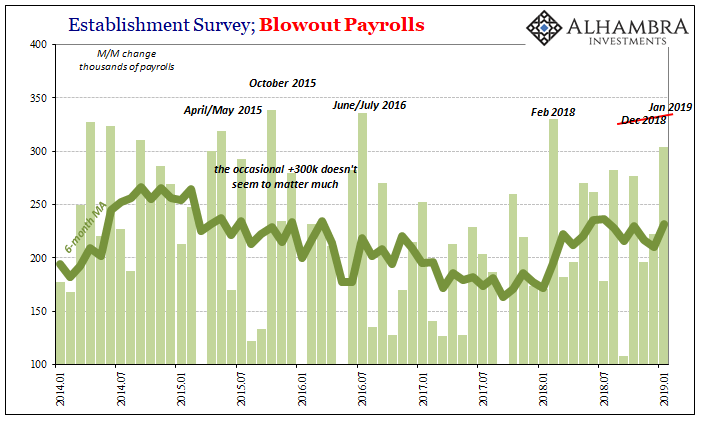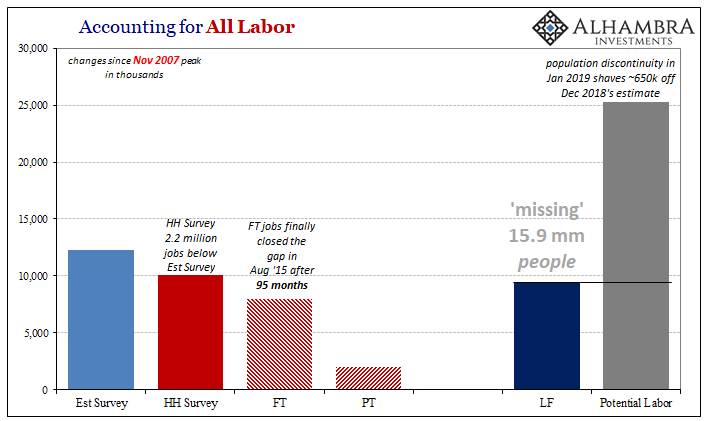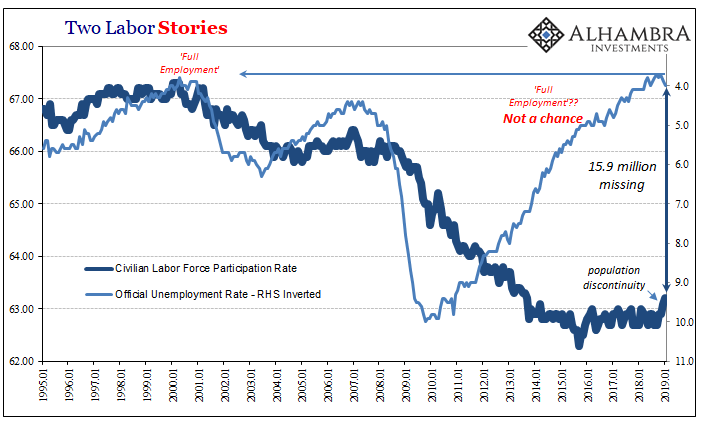It’s been awhile since we’ve had any data on the US economy. With the federal government having been shut down, especially the Census Bureau, the figures have gone dark. The current short-term government reopening will lead to an eventual rush of estimates, perhaps a few series that will be updated two months at a time.
In lieu of all that, the dataset that breaks the silence is the payroll report. Hooray. When we last left it the US economy was booming big, at least according to the BLS headline. The release was a perfect smash, the Establishment Survey coming in at +312k and with flawless timing to help soothe rather dire market sentiment after a traumatic December.
The new data for January 2019, released today, includes the standard annual benchmark update. There wasn’t much change in either direction from the revisions, save December’s number. Just like that it’s gone, vanished. That extremely helpful +312k has been replaced by +222k instead.
The stock market would likely have been bid anyway given its grave misunderstanding of what it is cheering in Powell’s pause, but you never know how +222k could’ve been interpreted rather than +312k. And there are more revision opportunities still ahead.
That’s the point with the payroll report. It is, overall, unreliable even as a coincident indicator. In terms of forward-looking, the data is and has been entirely irrelevant and not just due to revisions and changing benchmarks.

The other part of the series, perhaps the more important part, is the wage data. Average hourly earnings had crept up over the last half of 2018. Economists tried to claim this was the long-awaited repercussion of the LABOR SHORTAGE!!! therefore proof the economy really was booming.
Only, the rate of change (gamma, the only thing that matters) was nothing like a tight labor market. Benchmark revisions here actually show that wage acceleration was lumpier and less determined than previously thought. The average hourly rate has been going up, but not in a straight line and with a gentler slope.

For January, the average wage actually decelerated (negative gamma!), 3.40% versus 3.50% in December. This means that for this last month anyway there won’t be any headlines about the highest wage growth in a decade.
The other statistics are less robust, as they can tend to be at times. The Labor Force was flat, while those not in it were reduced by an unusually large 639k. This wasn’t an improvement so much as a statistical discontinuity. As happens almost every year, the Census Bureau hitches or appends new population data onto the prior years without refiguring the whole series.
For January 2019, then, the Civilian Non-Institutional Population was reduced by 649k. This doesn’t mean that America lost a lot of Americans, rather population growth (net) wasn’t as much as previously estimated. Several related labor market measures are adjusted the same way as a result.



The US economy is “only” missing about 15.9 million potential workers this month.
In short, the payroll report for January 2019 tells us nothing that we didn’t already know. The month-to-month changes shouldn’t be given much consideration, wage acceleration while good is nothing like a labor shortage (one sure reason why the Fed flip flopped to “muted” inflation outlook), and the economy isn’t recovering no matter how many people are thought to be contained or not contained within it.
This is a shame payrolls are the first one up, the initial visual produced for what seems like it could have been a crucial month.

Stay In Touch